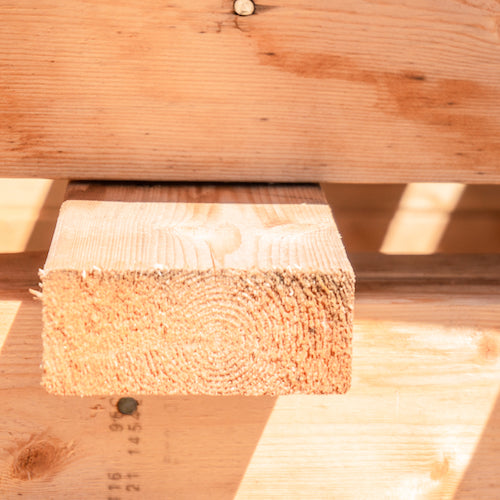The Risks of Treated Timber in Playgrounds and Garden Beds
Posted on January 16 2024
Growing your own vegetables has many benefits; as well as being cheap and convenient to access from your own backyard, it can provide a healthier alternative to supermarket bought produce. While we tend to consider the health risks of using products such as pesticides, what is commonly overlooked is the potential toxicity in the materials that we use to build our garden beds.
This informative article from Low Toxin Rabbit explains the dangers of using treated timber when building gardens and playgrounds, including why young children are particularly vulnerable. There's also suggestions for safer building materials and how to minimise your exposure to harmful toxins if you currently have treated timber in your garden.
The Risks of Treated Timber in Playgrounds and Garden Beds: A Cautionary Tale for New Zealanders
When it comes to building garden beds, the choice of materials is crucial not only for the health of your plants but also for your own well-being. In New Zealand, treated timber with a green-grey hue, commonly referred to as copper chromium arsenic (CCA) treated wood, has been a popular choice for constructing garden beds and outdoor structures. However, many gardeners are unaware of the potential health and environmental risks associated with this type of wood. In this blog post, we'll look at why you should avoid treated timber in garden beds, particularly in New Zealand where CCA treated wood is still being used despite being banned overseas. We'll examine the health risks of arsenic exposure, suggest safer alternatives, and cover safeguards you can put in place if you have treated timber garden beds already!
Understanding the Dangers of Treated Timber
CCA-treated timber, commonly used in outdoor wood structures, contains copper, chromium, and arsenic. These heavy metals are used as preservatives to prolong the lifespan of the wood. However, these toxic chemicals don't decompose or disappear over time like organic compounds. Instead, they leach into the soil and water, polluting the environment and posing health risks.
Health Risks of Arsenic Exposure
Arsenic is a known carcinogen and has been classified as one of the top ten chemicals of major public health concern by the World Health Organization (WHO). Long-term exposure to arsenic has been linked to various health issues, including cancer, skin disorders, and damage to internal organs. While acute poisoning from arsenic is unlikely, chronic exposure through touching contaminated soil or ingesting trace amounts over time can lead to serious health problems.
Children's Vulnerability
Children are particularly vulnerable to the effects of arsenic exposure due to their smaller body size and developing immune systems. In New Zealand, treated-timber playgrounds and residential buildings, where children spend a significant amount of time, are often constructed with CCA-treated wood. The risk of exposure is amplified as children touch the wood and soil, potentially transferring toxic residues to their hands and mouths.
Safer Alternatives and Precautions
Instead of using treated timber, consider safer alternatives for constructing garden beds. Untreated wood options like Macrocarpa, Douglas fir, or Lawson cypress offer a more eco-friendly and healthier choice for your garden projects. Additionally, concrete blocks, or stones are viable alternatives that don't pose the same risks as treated wood.
Reducing Risks and Protecting Your Family
If you currently have treated timber gardens beds or other outdoor structures, take precautions to minimize exposure:
Avoid Direct Contact: If treated wood must be used, avoid direct contact with the wood surface. Consider covering it with plastic or a sealant to prevent skin contact.
Maintain Distance: Avoid eating off treated picnic tables or playgrounds. In garden beds plant edible crops at least 12 inches away from treated wood to minimize arsenic leaching into the soil.
Wash Hands: Always wash your and your children's hands, especially after playing outside on playgrounds or in dirt.
Thoroughly Wash Produce: Wash garden produce thoroughly to remove any soil particles that may contain arsenic or other contaminants.
Peel Root Crops: If you grow root crops near treated wood, peel them before consumption to reduce potential exposure.
Use Protective Gear: If working with treated wood, wear gloves, dust masks, and eye protection to minimize contact and inhalation of harmful particles.
Do not ever burn treated timber: it releases arsenic into the air and surrounding environment!
Despite International Bans New Zealand's Still Chooses CCA-Treated Timber
Despite international bans and restrictions on CCA-treated wood, New Zealand continues to use it extensively, especially in playgrounds and residential buildings. The lack of awareness and regulatory enforcement has allowed the legacy of CCA-treated timber to persist, posing risks to both human health and the environment. In fact, New Zealand's arsenic concentration in the air during winter exceeds the country’s ambient air-quality guidelines! This is caused by many burning CCA-treated timber in log fires and burn-offs in the agricultural sector. Among 35 countries included in a study, New Zealand stood out as the only nation where the presence of arsenic in household dust exceeded the safe limit for children's health risks. Quite alarming for a country known for its clean and green image!
The risks associated with treated timber in garden beds, particularly CCA-treated wood, are significant and should not be underestimated. It's essential to prioritize the health of your family, the environment, and future generations. By choosing safer alternatives and adopting precautionary measures, you can create an outdoor space that thrives without compromising your well-being. Let's encourage the shift away from harmful treated timber practices and towards sustainable and health-conscious choices.
References:
https://environment.govt.nz/assets/Publications/Files/ambient-guide-may02.pdf
https://www.who.int/news-room/fact-sheets/detail/arsenic
https://www.sciencedirect.com/science/article/abs/pii/S0301479705000113
https://www.gns.cri.nz/news/high-arsenic-levels-in-urban-air-a-health-hazard-study-shows/
https://pubs.acs.org/doi/10.1021/acs.est.1c04494


